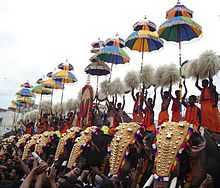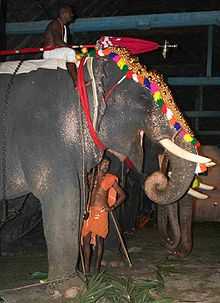Elephants in Kerala culture
This article covers the role of elephants (Indian Elephant, Elephas maximus indicus) in the culture of Kerala state, southern India.
Elephants found in Kerala, the Indian Elephants, are one of three recognized subspecies of the Asian elephant. Since 1986, Asian Elephant has been listed as endangered by IUCN as the population has declined by at least 50% over the last three generations, estimated to be 25,600 to 32,750 in the wild. The species is pre-eminently threatened by habitat loss, degradation and fragmentation.[1] Along with a large population of wild elephants, Kerala has more than seven hundred elephants in captivity. Most of them are owned by temples and individuals. They are used for religious ceremonies in and around the temples, and a few elephants work at timber yards. Elephants in Kerala are often referred to as the "sons of the sahya"(cf. poem Sahyante Makan by Vyloppalli Sreedhara Menon). As the State Animal, the elephant is featured on the emblem of the Government of Kerala state, taken from the Royal Arms of both Travancore and Cochin.
Elephants in festivals

Most of the Hindu temples in Kerala own elephants, the majority of which are donated by devotees. The famous Guruvayur temple has more than 60 captive elephants. The world's only Elephant Palace is constructed in Punnattur Kotta, 3 km from the Guruvayur temple, to house the temple's elephants. A famous elephant, named Guruvayur Kesavan, belonged to this temple.
Almost all of the local festivals in Kerala include at least one richly caparisoned elephant. Elephants carry the deity during annual festival processions and ceremonial circumnambulations in the Hindu temples. The temple elephants are decorated with gold plated caparisons ("nettipattam"), bells, and necklaces. People mounted on the elephants hold tinselled silk parasols ("muttukuda") up high, swaying white tufts ("vencamaram") and peacock feather fans ("alavattam") to the rhythm of the orchestra.[2] Seventeen elephants are engaged for the daily ceremonial rounds to the accomplishment of Pancari Melam in Kudalmanikyam temple. The headgear of seven of these elephants is made of pure gold and rest of pure silver, which is unique to this temple.
Elephants in history and legends of Kerala

Many elephants are featured in the local legends of Kerala. Aitihyamala ("A Garland of Historical Anecdotes") by Kottarattil Sankunni was written in eight volumes; each volume ending with a story or legend about a famous elephant. .
Caring for elephants
Each elephant has three mahouts, called paappaan in the Malayalam language. The most important duty of the mahouts is to bathe and massage the elephant with small rocks, and the husk of coconuts. In the monsoon season, the elephants undergo Ayurvedic rejuvenation treatments which include decoctions with herbs, etc. It is called Sukha Chikitsa in the Malayalam language. Mahouts may be classified into three types, called in the Sanskrit language:
- Reghawan: Those who use love to control their elephants.
- Yukthiman: Those who use ingenuity to outsmart them.
- Balwan: Those who control elephants with cruelty.
In November 2014, Mathrubhumi reported the incident of a tamed elephant, Indrajit, being released to the wild because of the care and affection (and not because of financial constraints) the elephant's owner, Mr T R Raghulal, has towards the elephant. To avoid troubles a tamed elephant may face in the wild, special arrangements were made by the forest-wildlife departments of the Government of Kerala, to ensure a smooth transition.[3] The elephant is 15 years old and is expected to live for another 50 years. Elephants have huge market value in a state like Kerala.[4]
Cruelty against elephants
Ownership of elephant is considered as a feudal status symbol and around 700 elephants are owned by people and temples. These elephants are rented out for more than 10,000 festivals and processions in which a single elephant may generate revenue up to $5000 a day according to their status.[5] These animals have to endure long and noisy parades, loud firecrackers, may need to stand near flames, travel long distances in open shabby vehicles and walk on tarred roads in the scorching sun for hours, denying even food, water and sleep, in the name of religion and tourism promotion.[5][6] They are often abused by drunk and brutal mahouts. Around half of the mahouts are found to have drinking problems.[5] January to April are the cruelest months for the captive elephants in Kerala when the places of worship celebrates various annual festivals. [6]
Elephant attacks
There is an alarming rise of man-animal conflict in crowded towns and cities, mostly believed to be happened because of maltreatment. During festivals elephants trampled and killed devotees in recent years. Kerala's Elephant Lovers' Association reports that in the period of 1998 - 2010 captive elephants have killed 212 people in Kerala - the majority of them mahouts. Wildlife authorities have warned that "fatal mishaps in public places at an alarming [rate have] become a threat to public life". [5]
Famous captive elephants
Some famous captive elephants in Kerala are,
- Thechikottukavu Ramachandran
- Guruvayur Keshavan
- Pambadi Rajan
- thrikadavoor shivaraju
Ornaments used for elephants
One of the famous families in Thrissur District of Kerala, the Venkitadri family, has made ornaments for three generations, especially for the famous Thrissur pooram, the most famous of the Hindu temple-centred festivals. They make gold plated caparisons, umbrellas, 'alavattam, venchamaram, and necklaces. They decorate one hundred and fifty elephants with ornaments for temple festivals. Thrissur Pooram, Nenmara Vallangi Vela are some of the famous festivals in kerala in which more decorated elephants are used for procession.
Devices used to control elephants in Kerala
In India, and especially in Kerala, mahout use three types of device to control elephants. Thotti (hook) which are 3.5 feet in length and 3 inches thick, Valiya kol (long pole) which are 10.5 feet in length and 5.5 inches in thickness, and cheru kol (short pole).
See also
- Kerala
- Thrissur Pooram
- Guruvayur Keshavan
- Punnathurkotta, elephant sanctuary in Kerala
- Konni, an elephant training center
- Temple elephants
- Kolakolli
- Temples of Kerala
- Elephants in captivity
- Cultural depictions of elephants
References
- ↑ Choudhury, A., Lahiri Choudhury, D.K., Desai, A., Duckworth, J.W., Easa, P.S., Johnsingh, A.J.T., Fernando, P., Hedges, S., Gunawardena, M., Kurt, F., Karanth, U., Lister, A., Menon, V., Riddle, H., Rübel, A., Wikramanayake, E. (2008). "Elephas maximus". IUCN Red List of Threatened Species. Version 2010.4. International Union for Conservation of Nature.
- ↑ South India. Rough Guides, 2003. ISBN 1-84353-103-8. P 305
- ↑ http://digitalpaper.mathrubhumi.com/380282/Weekend/23-NOVEMBER-2014#page/1/1
- ↑ http://www.thehindubusinessline.com/news/states/elephant-renting-is-now-jumbo-business/article4949312.ece
- ↑ 5.0 5.1 5.2 5.3 "BBC South Asia: India's overworked elephants". BBC. Retrieved 2012-08-11.
- ↑ 6.0 6.1 "Cruelty against elephants". The Hindu. Retrieved 2012-08-11.
External links
| Wikimedia Commons has media related to Temple elephants in Kerala. |
- Hasthyaayurvedam (Encyclopaedia of elephants and their treatment) The original book is in Sanskrit but Vaidyamadham Cheriya Narayanan Namboodiri has translated Paalakaapyam (Hasthyaayurveda) from Sanskrit to Malayalam.
- Association of elephant lovers to protect elephants.
- Mahout manual.